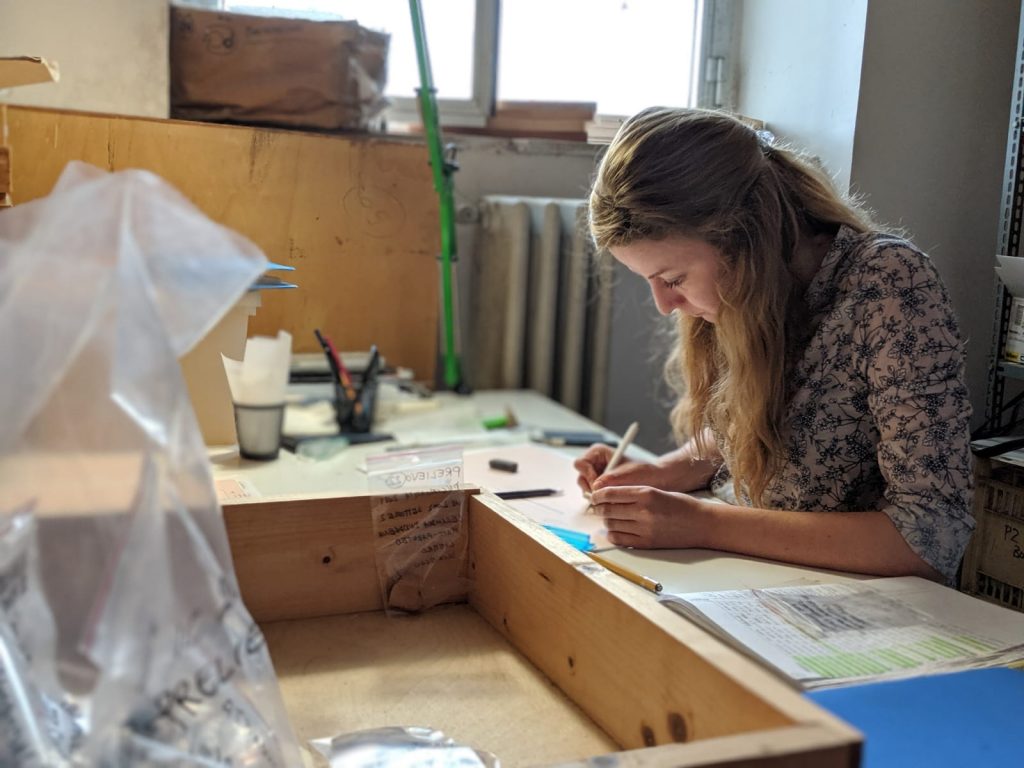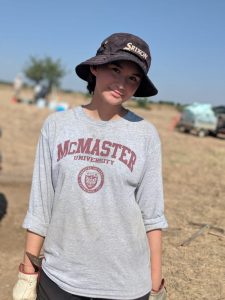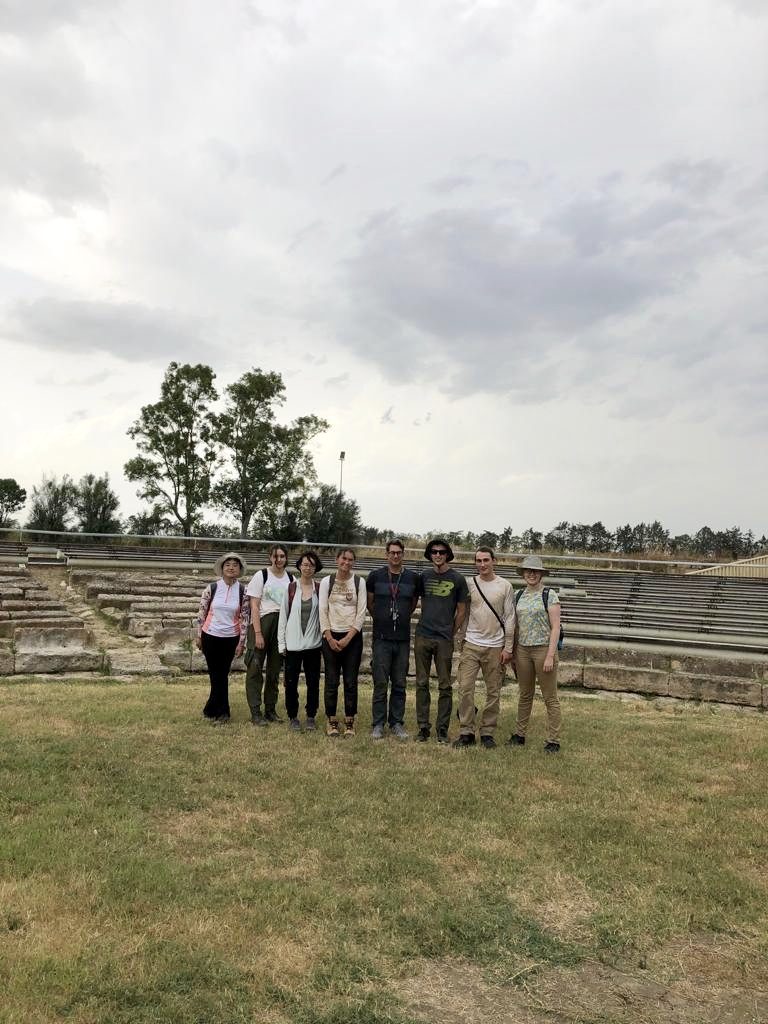Unearthing Greek settlements in Italy

From left to right; gradaute students Jayden Lloyd, Christine Davidson, Adrian Proestos, archaeologist Felice Perciante, graduate student Eric Del Fabbro and undergraduate Shanna Ingram.
Shanna Ingram is a fourth year biology student with a minor in classics. Under the direction of associate professor Spencer Pope, Faculty of Humanities, she and a team of students traveled to Metaponto, Italy. The goal: To piece together the history and artifacts of the ancient Greek settlement of Metaponto.
Popular culture has seen archaeology through the lens of many famous novels and movies, most notably Lara Croft in Tomb Raider and Steven Spielberg’s Indiana Jones. I grew up watching the thrills of discovery and archaeology’s ability to reveal secrets of the past.
At first glance, many discoveries in the field seem far less glamorous than those represented in fiction — it may just be that you find small sherds of pottery — but these items too can reveal a lot about the past. The smallest fragments tell a comprehensive story about a site. A freshly unearthed potsherd is no less spectacular than Indiana Jones’ lost ark.
Archaeologists who are interested in the Mediterranean civilizations of ancient Greece and Rome consider themselves Classical archaeologists. Our research was based in Southern Italy, what the Romans used to call “Magna Graecia,” or Great Greece, for its heavy Greek influence. By the early eighth century BC, droves of Greek merchants were sailing the coasts of Western Italy forming proto-colonial contact, leading to trade posts and eventually permanent settlements. What remains on the surface are modern towns like Metaponto. If you dig deep enough to reveal ancient Metapontum, you will find it is rich with indigenous and Greek context regarding their earliest dynamics.

In July 2019, after two previous seasons of surveying and gathering GPS data at a site called Incoronata in Metaponto, a team of undergraduates, graduates, and professional collaborators led by Dr. Sveva Savelli and Dr. Spencer Pope began excavation.
Around 7.5 kilometres from the coast of Basilicata, the plateau site of Incoronata sits 60 metres above sea level overlooking the Basento river valley. The Metaponto team extensively used drone technology to map out the area with high-resolution aerial imagery of the landscape. Incoronata has provided a rich record of interactions during the 8th and 7th century BC between indigenous Oenotrians and Aegean Greeks, well before the neighbouring apoikia of Metaponto was founded.
Incoronata’s vast body of growing research has been carried out by various groups on different spurs of the hill since the 1970s. These investigations were led by University of Milan, Soprintendenza Archeologica della Basilicata, University of Texas at Austin, University of Rennes 2, and now very recently also included McMaster University. Despite previous excavation, Incoronata has proven there is still much to be revealed.
The Oenotrian phase sprawled from the 9th century BC until the beginning of the 7th century BC. From the 8th century BC down to the third quarter of the 7th century BC, there was an indigenous community open to Greek influence and commercial interaction. Hundreds of containers, amphorae and pithoi, were found in what could be a storage or warehouse facility where it is likely that an indigenous elite managed this mixed activity. This finding alludes to commercial or craft activity in a crossover space where the Greek and non-Greek spheres collided.

The University of Texas at Austin dug on the southeast spur of the plateau and excitedly revealed another phase of occupation during the 6th century BC. The presence of female terracotta statuettes and Ionian cups point to religious practice and something magnificently monumental. This is where our 2019 trench begins to take shape, and this is also where I will leave the rest of the story for your own imagination.
I feel very privileged to have dug alongside such a supportive and knowledgeable team in the first McMaster-led excavation at Incoronata. I learned new skills in both excavation and lab methods that I will be able to add to my archaeological repertoire and apply to my future field endeavours.
The site of Incoronata is incredibly dynamic. The McMaster team will be able to see where this trench and its surrounding area fit into the site’s complex chronology in subsequent dig seasons.
I have spent quality time alongside other scholars on the team, including Christine Davidson, Classics PhD candidate, who has been on the project for two consecutive seasons. She shared her experience with me:

What did you take away from your first excavation?
I took away an appreciation for how complex it can be to break ground in an unexplored area. It’s so important to preserve the contexts of material as much as possible because of it’s value. Being attentive to slight changes in soil and logging new strata is a very difficult but exciting process. It taught me that I have a lot to learn.
How did the field experience enrich your learning in the classroom?
While I’m no longer a student in the classroom, I definitely feel that I am better able to describe material culture to students after being in the field. I encourage other students to seek out a similar experience outside the classroom.
What is it about Metaponto that makes you want to return again?
The feeling that you’re really discovering something entirely new in the study of Magna Graecia. What we find at Incoronata and in doing survey around Metaponto will be invaluable in the study of Greek colonies. Yet, since we inherited the living and work spaces of teams before us, we have a comfortable and established place in which to operate in this project. That’s actually incredibly rare for an archaeological team. And the food is pretty stellar too.
Do you have any advice for students seeking field experience?
If at all possible, definitely get out in the field! And (for Classics students) if that’s not possible, still try to find ways to visit Italy or Greece (I know there’s several avenues for undergraduates to get funding to travel- that’s how I did it many years ago). The increase in understanding things like scale, landscapes, distance etc. is so definitely worth it. For those who do make it into the field, you will be living and working with the same people for weeks (months!) and in that time can form some incredible relationships, both professional and personal. It’s an opportunity to work closely with your professors and make some wonderful friendships along the way. And should personalities clash, remember to be kind, patient, and enjoy the wonderful experiences your time abroad has to offer! How fortunate are we that our study and job features travel around the world?!



